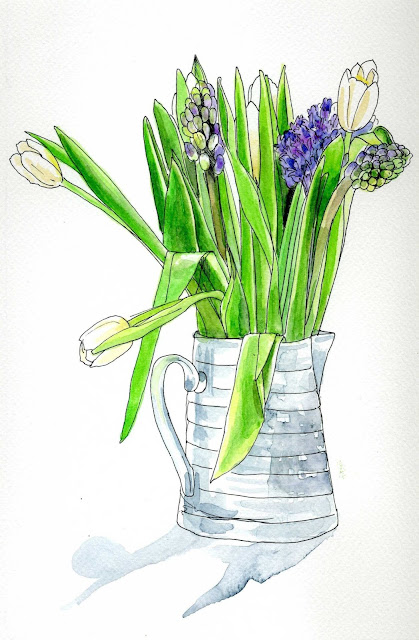How to Paint a vase of Flowers
with waterproof ink and watercolour
1. Make sure you like the surface it's on - I don't like if it's crumpled (much) or too elaborate as you've usually had enough by the time you come to the end of the flowers. Then again, that can make for a very rushed tablecloth or whatever, and that can be lovely.
2. Do you like the jug or vase? Will it set off the flowers nicely? Choose one you like. A jam jar can be gorgeous, if it's clean.
3. Are the flowers sitting nicely? Then begin...
Positioning the subject on the page
1. Even if I don't do much in the way of pencil sketching, I always make sure the subject will fit on the page as I'm always leaving too little room. So I rough out a shape in pencil.
2. I do rough ovals for the flower heads, and rough leaf shapes, and a nice rough jug or vase shape.
3. Here's the crucial bit.
Look.
Look, and look again, and again. In fact, you won't stop looking for so much as five seconds until you're done. The answers are not in your head, they are on the page. Don't bother photographing your subject, because the answers aren't there either.
Finding the answers
Ah...but what are the questions?
Here are a few:
What shape are those leaves?
How does that one relate to that one?
Is that stem in front of or behind that one?
These can be drawn in a 2B pencil but with a very light line - no gouging heavy black lines on to the page because...
(a) they will be impossible to remove
(b) if they're wrong, they will make the picture look horrible, especially if you can't remove them (see (a) above)
So, where are we? We are looking, and determining, and looking, and paying attention, and not looking for answers in our heads, but in the subject in front of us.
Inking your lines
When you are happy that you have a more or less correct rough pencil shape, it is time to switch media.
I use a waterproof Carbon black cartridge pen by Pelikan. It has a nice smooth nib, which is vital for fluid lines.
This is the tricky bit. It's easy for me because I am very confident but the pencil line will lend you this confidence, especially if it's correct.
A word about correct lines:
All the lines occur in their own space and as long as you don't move them they have a fixed position with reference to the line next to them. It's up to you to look carefully and make sure they are in the right place.
There is NO SUBSTITUTE for a correct line. No amount of splashing pretty bits of colour around, no gimmicky techniques, nothing will make up for a wrong line.
"But I can't get my line right," you say. There's only one reason for that - you're not looking hard enough.
Tip:
Start with just the one flower. Try drawing it a few times till you start to improve. A whole jugful might be a little strenuous.
Good news: it doesn't matter at all if you make a mistake. heaven knows why, but it doesn't seem to make the drawing look worse...AS LONG AS you paint only the correct one. You must tell the viewer which one is the correct one.
In the end you should have a really nice drawing in ink, and it should be good-looking enough for you to think, "Will I bother painting it?"
Tomorrow: Painting it



